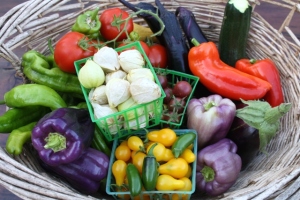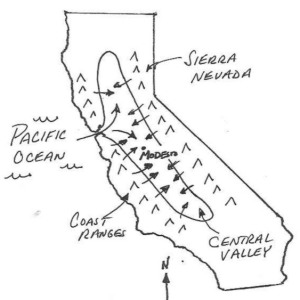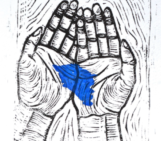
Food prices in the United States are increasing slightly but not as significantly as one might expect given the severe drought in California. Margret Munro, a science journalist with Postmedia, recently asked me a great question: is groun dwater depletion keeping California fruit and veggies cheap during the severe drought? Following up on her article, here is what I found and what it means for the Central Valley aquifer system in California.
dwater depletion keeping California fruit and veggies cheap during the severe drought? Following up on her article, here is what I found and what it means for the Central Valley aquifer system in California.
What is the Central Valley aquifer?
The Central Valley aquifer system is a large, complex aquifer system. Permanent loss (or depletion) of groundwater in the Central Valley aquifer may pose a threat to the agricultural economy of the U.S. since market value of agricultural products grown in there contributed up to 7% of the nation’s $300 billion in agricultural revenue in 2007. Recently, we have shown how different crops lead to groundwater stress across the Central Valley.
Why are food prices not increasing?
According to NPR’s Dan Charles there are three reasons why food prices are not increasing: 1. some farmers have backup water supplies, and much of this is groundwater; 2. some parts of California are less dry than others; and 3. the limited water is going to crops that consumers are most likely to notice.
Is groundwater pumping increasing?
Previous studies by the USGS have shown that groundwater pumping increased during previous. During the last drought, this increase in pumping was even seen in GRACE satellite data, which was updated in a more recent report. Another recent study from University of California Davis suggests surface water deliveries will be reduced by an estimated 6.5 million acre-feet and partially replaced by an increase of 5 million acre-feet of groundwater pumping (compared to the normal quantity of 20 million acre-feet). The research team estimates nearly 410 thousand acres being fallowed, resulting in a reduction in gross farm revenue of $738 million.

Groundwater depletion caused the land to subside at the rate highlighted by the years on the telephone pole (USGS)
What are the potential impacts on the Central Valley aquifer?
A study of major aquifers in the United States suggests only 20% of the pumpage of the Central Valley aquifer comes from the depletion of stored groundwater. Most of the pumpage comes from increased recharge due to artificial irrigation. This can lead to groundwater contamination by fertilizers or pesticides and or decreased baseflow to rivers, which can impact the environment. Other potential impacts are aquifer compaction, which causes land subsidence and increased pumping costs. As a previous post described, this may even be moving the nearby Sierra Nevada Mountains!
What is next?
This drought seems to be encouraging California to modernize water management. Now, California seems to poised to pass new groundwater regulations. Go Governor Jerry Brown, Go!






Matthew Currell
Another major effect is well interference. When water levels drop due to high irrigation usage, shallow domestic wells run dry: http://www.circleofblue.org/waternews/2014/world/californias-dogged-drought-cutting-water-supplies-states-poor/
mattcurrell
Another major impact is well interference. When water levels drop due to high irrigation usage, domestic water wells run dry:
http://www.circleofblue.org/waternews/2014/world/californias-dogged-drought-cutting-water-supplies-states-poor/
Pingback: Bloggers on groundwater, drought, climate change and more … » MAVEN'S NOTEBOOK | MAVEN'S NOTEBOOK